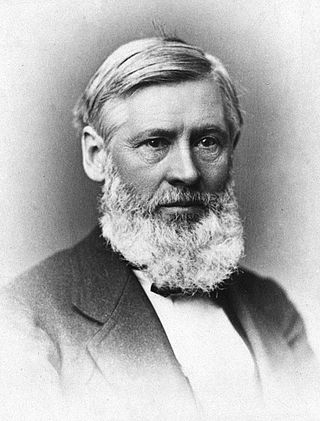
Leighton is a town in Colbert County, Alabama, United States. It is part of the Florence - Muscle Shoals Metropolitan Statistical Area known as "The Shoals". At the 2020 census, the population was 665. Leighton has been hit by several tornadoes in the 2000s, including a damaging EF2 on May 8, 2008, that was caught on tape flipping over many cars and damaging buildings.

Moulton is a city in Lawrence County, Alabama, and is included in the Decatur Metropolitan Area, as well as the Huntsville-Decatur Combined Statistical Area. Although it incorporated in 1819, along with its rival of Courtland, to compete for the honor of county seat, it did not first appear on the U.S. Census rolls until 1900. As of the 2010 census, the population of the city is 3,471, its record high. The city has been the county seat of Lawrence County since 1820. It has been the largest community in the county since the 1920 U.S. Census.

Asa Gray is considered the most important American botanist of the 19th century. His Darwiniana was considered an important explanation of how religion and science were not necessarily mutually exclusive. Gray was adamant that a genetic connection must exist between all members of a species. He was also strongly opposed to the ideas of hybridization within one generation and special creation in the sense of its not allowing for evolution. He was a strong supporter of Darwin, although Gray's theistic evolution was guided by a Creator.

George Engelmann, also known as Georg Engelmann, was a German-American botanist. He was instrumental in describing the flora of the west of North America, then very poorly known to Europeans; he was particularly active in the Rocky Mountains and northern Mexico, one of his constant companions being another German-American, the botanical illustrator Paulus Roetter.
Thomas or Tom Peters may refer to:

Charles Theodor Mohr was a pharmacist and botanist of German descent who lived and worked in the United States.

Edward Lee Greene was an American botanist known for his numerous publications including the two-part Landmarks of Botanical History and the describing of over 4,400 species of plants in the American West.
Thomas Johnson was an English botanist and academic renowned as an expert and cataloguer of the world's algae, fungi, and fossil plants.
Arthur Stanley Pease was a professor of Classics, a respected amateur botanist, and the tenth president of Amherst College in Amherst, Massachusetts. Pease was once described by his fellow faculty members as an "indefatigable pedestrian, and New Englander to the core."

William Baldwin was an American physician and botanist who is today remembered for his significant contributions to botanical studies, especially Cyperaceae. He lived in Pennsylvania, Delaware, and Georgia, and served as a ship's surgeon on two voyages overseas. He published only two scientific papers, but his major contributions were in the knowledge that he imparted to other botanists in his letters to them and in the thousands of specimens that he provided for their herbaria. He wrote letters to Henry Muhlenberg, Stephen Elliott, William Darlington, Zaccheus Collins, and others. His most important collections were from Georgia, Florida, and eastern South America. When he died, he left a large herbarium that proved to be of great value, especially to Lewis David von Schweinitz, John Torrey, and Asa Gray. He had a special interest in the plant family Cyperaceae and his incomplete, unpublished manuscripts were a major source for monographs by John Torrey and Asa Gray. The historian Joseph Ewan has said that "Baldwin's treatment of a number of genera, especially in the Cyperaceae, showed penetrating observation, understanding, and diagnosis". The genus Balduina was named for him by Thomas Nuttall. Most of what we know of him is from the biography written by his friend, William Darlington, in 1843.

George Francis Atkinson was an American botanist and mycologist.

Sara Allen Plummer Lemmon (1836–1923) was an American botanist. Mount Lemmon in Arizona is named for her, as she was the first Euro-American woman to ascend it. She was responsible for the designation of the golden poppy as the state flower of California, in 1903. A number of plants are also named in her honor, including the new genus Plummera, described by botanist Asa Gray in 1882.
John Gill ("J.G.") Lemmon was an American botanist and Civil War veteran and former prisoner of Andersonville. He was married to fellow botanist, Sara Plummer Lemmon, and the two jointly cataloged numerous western and desert plants.
Frances Margaret Leighton was a South African botanist and educator. After graduating from Rhodes University with her M.Sc degree in 1931, she worked at the Bolus Herbarium until 1947. Her primary research interests were focused on monocots, and her work impacted the Ornithogalum and Agapanthus.

Rose Eudora Collom was an American botanist and plant collector. She was the first paid botanist of the Grand Canyon National Park. She discovered several plant species, some of which were named in her honor, and collected numerous plant specimens.

Wilhelm Nikolaus Suksdorf was an American botanist who specialized in the flora of the Pacific Northwest. He was largely self-taught and is considered one of the top three self-taught botanists of his era for the Pacific Northwest, alongside Thomas Jefferson Howell and William Conklin Cusick.
David Greenhill Ligon was an American jurist who served as a justice of the Supreme Court of Alabama from 1851 to 1854.
Rev. Thomas Morong was an American botanist and clergyman.
Thomas Grant Harbison (1862–1936) was an American botanist.

Thomas Conrad Porter (1822–1901) was an American botanist and theologian known as an expert on the flora of Pennsylvania.













